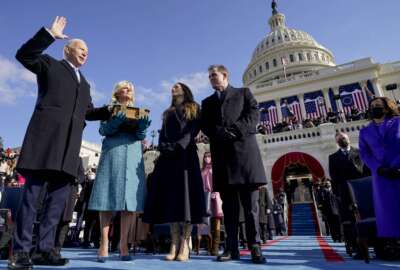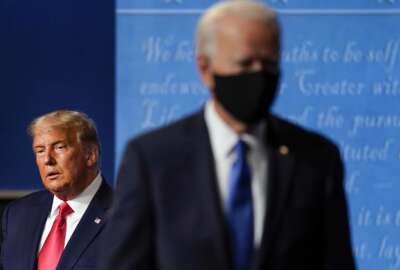
Why presidential transition planning makes or breaks an administration
Like most of the public, federal employees stand by and watch as presidential administrations come and go. Every president is flawed, but they have varying degrees...
Best listening experience is on Chrome, Firefox or Safari. Subscribe to Federal Drive’s daily audio interviews on Apple Podcasts or PodcastOne.
Like most of the public, federal employees stand by and watch as presidential administrations come and go. Every president is flawed, but they have varying degrees of success in office. Success is highly influenced by how carefully presidents prepare for their transitions to office. This interview by the Federal Drive with Tom Temin is with the co-author of what might be the first definitive study of modern transitions, which includes interviews with transition planners themselves. That co-author is David Marchick, currently the Dean of the Kogod School of Business at American University.
Interview transcript:
Tom Temin: You have been a scholar, you might say of presidential transitions for a long time you did the project for the Partnership for Public Service.
David Marchick: I did, it was a great project. And the project had a lot of impact on the 2020 transition, just like it did on other transitions since 2008.
Tom Temin: And we tend to think of transitions as kind of administrative formalities. But I want to read one passage from page 28 of your book, you say it is inarguable that presidential transitions serve as a critical juncture in history, a moment of flux, where political actors are granted an uncommon degree of freedom; taking stock of these moments can offer deeper insights about our history and arm practitioners with the knowledge needed to take advantage of future opportunities. That seems to be the reason for this book.
David Marchick: Well, your listeners have been through transitions either in government agencies, in corporations, in institutions, change is hard. The way that the transitions are planned for the U.S. government makes it even harder, a new president has to appoint 4,000 new political officials, 1,250 of them are confirmed by the United States Senate. In essence, the entire layer of the government leaves and a new layer comes in. And it creates a huge moment of vulnerability for our country. One which effective planning can help overcome.
Tom Temin: And how is it different here say then Great Britain, we saw a sort of quick come and go of a prime minister not long ago, a couple of months. And don’t they have a similar situation? What’s unique about the American system?
David Marchick: In most democracies, you don’t have the same level of turnover. In the U.K., for example, a new prime minister comes in even if there’s a change in party, they may bring in five or 10 aides, a bunch of new ministers, and each minister will have maybe one or two new people. Here you have 10 or 15 layers of the government leave and a new layer come in, it’s very disruptive. And it places a huge burden on the career civil servants.
Tom Temin: Right. So it’s almost a legacy of when civil service was spoils. And now it only the spoils only go back down two or three layers, and then you get to the standing workforce. But those two are three layers deep, that are politically appointed, are about everything related to the philosophy of the incoming president.
David Marchick: Absolutely. And what we saw in 2020, as we’ve seen before, an effective transition can have a huge impact on the success of an entire administration. And a poor transition can imperil a new administration.
Tom Temin: Right, let’s talk about some of the anecdotes you’ve described in detail of most of the recent transitions going back to Jimmy Carter, who you described as the first modern president to really pay attention to transition planning. And yet the mistakes that he made resulted in a presidency that was less than effective.
David Marchick: So Jimmy Carter did a good job in that he was the first candidate in the modern era to allocate time, resources and staff to transition planning. That’s positive. Prior to that nobody really did that. He made one fatal mistake, which was he didn’t tell his campaign that a transition team existed. And so about a week before the election, news reports started to show up saying Carter was planning this, Carter was planning that, and the campaign team didn’t know anything about it. So Stu Eizenstat in my book said, he went to Jimmy Carter, Stu was the domestic policy adviser. And he said, where are these stories coming from? And Carter said, “Oh, I didn’t tell you. I have a transition team.” And so that created a clash between the campaign team who felt they got Carter elected, and the transition team who said, “We’re the smart ones, we know how Washington works, the campaign people, they can just go to the side.” And Stu says that, that clash imperiled the first year of the Carter Presidency, it slowed it down. It made it much more difficult, and it gave Carter a slow start.
Tom Temin: And he was only to have one term so that the entire effectiveness of his presidency was limited by what happened in that first year.
David Marchick: Exactly. He didn’t have a chief of staff. He didn’t have an organized government, he allocated too much time and resources to selecting the cabinet, as opposed to the White House staff. Reagan learned from those mistakes.
Tom Temin: Right? That was the exact opposite approach.
David Marchick: Reagan came in and he said, I’m going to have someone who really knows how to govern, be my chief of staff. He picked Jim Baker, who went on to become treasury secretary and secretary of state probably the most important unelected official in the post-war era. Baker had run two campaigns against Reagan. He ran the Ford campaign and then the Bush campaign tried to take Reagan out. Reagan had the confidence to say I want the best person to run my government, even if he’s not Reagan loyalist, and that paid off for Reagan.
Tom Temin: In some ways he reached back to lessons from Lincoln in that regard.
David Marchick: Absolutely. Lincoln, famously Doris Kearns Goodwin a highlights this had a team of rivals he picked who he thought were the best people, even if they were not going to get along perfectly. He knew he was strong, he knew he was a good leader, and he could deal with friction.
Tom Temin: We’re speaking with David Marchick, Dean of the Kogod School of Business at American University, and co-author of “The Peaceful Transfer of Power and Oral History of America’s Presidential Transitions.” And in the modern era, which I guess could define as the era of mass communications. You also describe Hoover to Roosevelt, we had radio then people could hear and see presidents and movie reels, something that was relatively new, that one wasn’t so good either because of the differences between the incumbent and the incoming.
David Marchick: So we’ve had really three very complicated transitions. Buchanan to Lincoln, Hoover to Roosevelt and Trump to Biden. In Hoover to Roosevelt during the four month period between the time when Roosevelt was elected, and when he was inaugurated, the Great Depression peaked. Banks ran in 25 states, Hitler came to power, the Reichstag burned and Japan left the League of Nations. And Hoover had disdain for Roosevelt, he thought he was a feeble mind and feeble body. And he didn’t want to help. So the country was literally coming apart for four months. And Hoover sat on his hands, his idea of helping Roosevelt was trying to convince Roosevelt to abandon the New Deal. Historians that I interviewed in my book say that that lack of cooperation, deepened the pain for American people, it lengthen the Great Depression, and a made recovery much more difficult.
Tom Temin: All right, and then if you go to the most recent one, Trump to Biden, that one is also an anomaly if never mind, what happened on Jan. 6, but the animosity was there, and I think Trump was the first to not attend the inauguration of a successor.
David Marchick: So there have been four presidents who did not attend the inauguration of their successor. The last one was Andrew Johnson. So that’s not really a good record. The transition was very challenging. On the one hand, President Biden, candidate Biden probably was the most prepared person ever to become president. He had 40 years in the Senate, he was vice president. He put together a fantastic transition team, they were organized, they anticipated all the challenges. Trump, on the other hand, impeded the transition, slowed it, many of us agencies didn’t cooperate. And this was at a time of four crises in the United States. We had a global pandemic, we had 11 million people out of work. We had a racial reckoning in the wake of George Floyd’s murder, and we had a political crisis. So literally, this was a matter of life and death. And the most important issue for Biden, when he became president was not a big policy issue. It was getting shots in arms, it was getting the vaccine out. So Americans could be safe. And Trump impeded collaboration between the incoming Biden team and the outgoing Trump team to get shots in arms.
Tom Temin: And at the beginning of his presidency, Trump did not really take much advice from anybody that might have helped him be more effective.
David Marchick: That’s right. He during the campaign, he hired Chris Christie, the former governor of New Jersey to run the transition. Chris Christie did a good job. He consulted with former transition leads, he put together a very effective organization. The day after the election, Steve Bannon called Chris Christie into Trump Tower and said, Chris, we need to make a few changes in the transition. And Chris Christie said, what? And he said you, you’re out and he fired Christie, and they threw away all the materials and started over. And Chris Christie, I said, what I asked him in the book, what was the impact of that? And he said Trump never recovered, the government never was organized. At the end of 100 days, Trump only had 28 confirmed officials in the entire United States government, 28. You can’t run a government with that few people in office.
Tom Temin: And in recent years, recent decades, I guess you could say the Congress has come to the realization that transition is not just something that should be haphazard. And now you have transition laws and procedures that give even candidates office space and so forth. Review for us what the structure is now legally, that makes sure that for those willing to take advantage of it, they can have a good transition.
David Marchick: So Congress has passed something called the Presidential Transition Act, and they’ve amended over several times. And now basically, they provide after the political conventions. They provide the candidates with office space, phones, computers, the ability to submit people through security clearances. They provide infrastructure so a candidate can plan. They also created a presumption that a candidate should plan for transitions. Before it used to be that candidates who had transition planning efforts were seen as presumptuous. They were seen as measuring the drapes. We want candidates to measure the drapes, we want them to be prepared. The Congress also requires the outgoing administration to collaborate with the incoming, prepare briefing books, meeting space and facilitate the new cabinet officers coming in. And they also require organization at the White House. So that’s positive. I think there’s a lot more that Congress can do to move things up to require transition planning earlier to provide more funding and to empower career officials to have more authority to facilitate the peaceful transition of power.
Tom Temin: Now, you David Marchick, you’re a Washington guy. You’ve worked for the Carlyle Group, you’ve worked for the Clinton administration, Partnership for Public Service, American University. And so you are versed in the ways of Washington, what brought you to your interest in this particular phase of politics, policy, the intersection of all of this in transition?
David Marchick: Well, I had the opportunity to run a project called the Center for Presidential Transitions at the Partnership for Public Service. It’s a nonprofit, nonpartisan organization focused on making government more effective. And I took on the project, not knowing that this would be the most tumultuous presidential transition since 1932. And so I hosted a podcast called Transition Lab. And it kind of took off. And I thought that all the lessons learned we learned from the transition process could add to the historical record, you know, every aspect of the presidency has been studied to death. There are 15,000 books alone on President Lincoln. But this is one area which has not been studied, and I thought I could contribute.
Tom Temin: And what’s been the reaction so far?
David Marchick: So far, it’s actually been pretty good. You know, the Wall Street Journal did a wonderful review of it. There have been lots of sales. It’s of significant interest. Ken Burns was nice enough to write the foreword. And I think that people look at the 2020 transition, Jan. 6, and the tension that was created, and they recognize that the peaceful transition of power is fundamental to our democracy.
Copyright © 2025 Federal News Network. All rights reserved. This website is not intended for users located within the European Economic Area.
Tom Temin is host of the Federal Drive and has been providing insight on federal technology and management issues for more than 30 years.
Follow @tteminWFED





